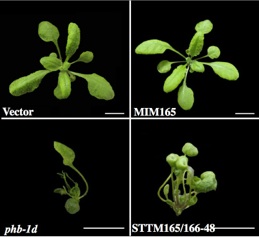Gene Silencing and Plant Molecular Biology


Research Interests:
Dr. Tang conducted his graduate research on the catabolic pathway of the essential amino acid lysine in the laboratory of Dr. Gad Galili at the Weizmann Institute of Sciences, Israel. He then moved to the laboratory of Dr. Phillip D. Zamore at the University of Massachusetts Medical School for his post-doctoral research on plant RNA interference (RNAi) and microRNA (miRNA) pathways. He established his independent Gene Suppression Laboratory at the University of Kentucky (UK) and became a tenured Associate Professor there. In October 2011, he moved from UK to Michigan Technological University (MTU) at the Michigan’s Upper Peninsula (U. P.) for a family reunion and enjoyed the first winter time with much outdoor activities with his wife and kids. In May 2016, he became a full professor.
Currently, Dr. Tang focuses on five general fields: (1) Plant and animal gene silencing using artificial miRNAs (amiRNAs) and tasiRNAs (tasiRNAs) and small tandem target mimic (STTM) for functional genomics of protein-coding genes and small RNAs and their related functional gene discoveries, (2) Development of plant dominant mutant resource for plant gene discoveries, (3) miRNA evolution, bioinformatics, designing and experimental testing, (4) miRNA profiling, functions, and regulation of target gene expression, (5) Plant abiotic stresses, and (6) Plant natural products. Specifically:
(1) For the study of plant and animal gene silencing, Dr. Tang’s main focus is to dissect RNAi and miRNA pathways via a biochemical approach using wheat and maize germ extracts, fly embryo lysate, Arabidopsis, and human cell cultures as well as a genetic engineering approach using amiRNAs, tasiRNAs and STTM for functional genomics of protein-coding genes and small RNAs. Specifically, Dr. Tang studies the assembly of RNA-induced gene-silencing complex (RISC), the complex-guided target mRNA cleavage or translational repression, and the regulation of RNAi and microRNA components such as Dicers and AGOs in vivo in plants and cell cultures, and in vitro in test tubes. Dr. Tang also studies to develop simple but efficient RNAi technologies for plant gene suppression. Supports to this project are from the USDA-NRI and recently from NSF PGRP.
(2) For the development of plant dominant mutant resource for functional genomics and gene discovery, we use RNAi gene discovery tool to randomly generate dominant mutant pools in plants. This project is currently suported by NSF and it will provide research training opportunities for one postdoctoral fellow and nine undergraduate and high school students. Underrepresented minorities and women, as well as students from rural eastern Kentucky, will be especially targeted and recruited.
(3) For the study of miRNA evolution, bioinformatics, designing and experimental testing, our objective is to design highly efficient miRNA-like siRNAs, miRNA-like structures that are far more beyond a simple mimic of natural miRNA genes. We are in a collaboration with Dr. Cingwen Li and Eva Li to build up a miRDuBase for storing miRNA duplexes of various species, and to develop a miRNA Designer program for miRNA-like siRNA designing for gene silencing The miRNA-like structures designed by this program will be extensively tested by experiments to improve the miRNA designer to its perfection. Eventually, a user-friendly web service of miRNA designer will be offered to our fellow scientists who are eager to avoid the costy try-and-error RNAi experiments to knock down their specific genes in plants and animal cells.
(4) For miRNA profiling, functions, and regulation of target gene expression, we developed a rational, cost-effective, high throughput miRNA array technology as a core facility at the University of Kentucky to serve our fellow scientists and our daily array analysis at the Tang Lab. We have successfully applied it in the analysis of miRNA profiles in plant development, different mouse organs or in identification of candidate miRNA biomarkers for cancer cells, Alzheimer's disease and diabetes complications. The array platform has been optimized with various titrations to a linear range. New methods for data adjustment, normalization and clustering analysis have also been introduced to improve array analysis. This array platform will be upgraded and scaled up immediately for wider uses and various kinds of studies. Transition of this technology to commercialization will be supported for two years (2008-2010) by an award from the Kentucky Science and Technology Corporation (KSTC). The regulation of target gene expression by miRNAs turned to be much more complicated than previously appreciated. We are currently focusing on understanding the observation that miRNA induces target mRNA degradation that is not associated with target cleavage by RISC-associated "slicer" activity. On the other hand, the regulation of miRNA biogenesis is also getting complicated. Increasing evidence indicates that miRNAs are not isolated individuals but belong to a network. Perturbation of this network will lead to feedback and auto-regulatory responses in change of miRNAs or the expression change of miRNA machinery. We are also focused on understanding these regulations.
(5) For the study of plant abiotic stress, we study roles of microRNAs in abiotic stresses in model plants Arabidopsis and Populus by identifying key miRNAs that are induced or suppressed during abiotic stresses. We are also developing random RNAi technology to screen for mutants in abiotic stress responses. This project is currently supported by another award from USDA-NRI.
(6) For the study of plant natural products, Dr. Tang collaborates with the faculties at the Kentucky Tobacco Research & Development Center (KTRDC) and the Department of Plant and Soil Sciences to dissect and to improve the plant metabolic pathways using genetic engineering and gene suppression technologies. The goal is to discover new useful plant natural products and to promote their production in plants. Support to this project is from the KTRDC
Recent Publication: http://www.ncbi.nlm.nih.gov/pubmed?term=Guiliang%20Tang
Research Areas and Systems:
Gene Silencing,
RNA Interference (RNAi),
MicroRNA (miRNA);
Wheat Germ Extract,
Drosophila Embryo Lysate,
Arabidopsis, and other Plant Systems.

Dr. Guiliang Tang
Professor
Ph.D. Weizmann Institute of Sciences, Israel, 2001
Office: Dow 406
Lab: Dow 416
Phone: 906-487-2174 (Office)
Email: gtang1@mtu.edu
Academic Services:
Associate Editor of BMC Plant Biology,